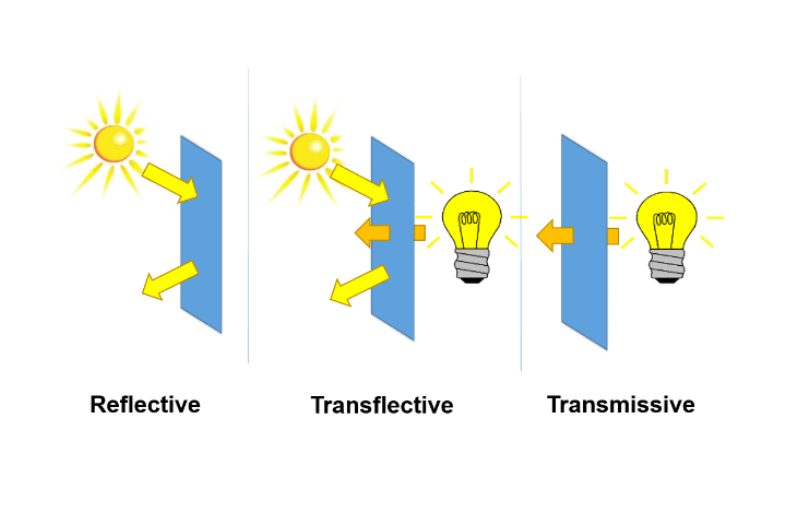Understanding TFT LCD Semi-Transmissive Technology

Thin Film Transistor Liquid Crystal Display (TFT LCD) technology has transformed the way we interact with visual media, from smartphones to televisions.
Among the various configurations of TFT LCDs, semi-transmissive displays stand out due to their unique ability to function effectively in both well-lit and low-light environments.
This blog delves into the intricacies of semi-transmissive TFT LCD technology, its advantages, applications, and how it differs from other display types.
What is a semi-transmissive TFT LCD?
A semi-transmissive TFT LCD combines both transmissive and reflective properties.
This means that it can utilize ambient light to enhance visibility in bright conditions while also having a backlight to illuminate the display in dim environments.
The display panel consists of liquid crystals sandwiched between two glass substrates, with a thin film transistor array controlling the pixel illumination.
In a standard transmissive display, light is primarily emitted from the backlight, whereas in a reflective display, light is reflected off the surface of the screen.
Semi-transmissive displays take advantage of both methods, allowing them to adapt to varying lighting conditions seamlessly.
How does it work?
The semi-transmissive TFT LCD operates using a combination of backlighting and ambient light.
During the day or in bright settings, the liquid crystals can manipulate incoming natural light, enhancing the display’s visibility without relying solely on the backlight.
This feature is particularly beneficial for outdoor use, where bright sunlight can wash out conventional displays.
In low-light conditions, the backlight provides the necessary illumination, ensuring that the content remains visible.
The technology is designed to optimize power consumption by reducing the need for backlighting in well-lit environments, thus extending battery life in portable devices.
Advantages of semi-transmissive TFT LCD
Enhanced visibility
One of the primary advantages of semi-transmissive TFT LCDs is their improved visibility in various lighting conditions.
Users can easily read content in bright sunlight or low-light environments, making these displays versatile for different applications.
Power efficiency
By utilizing ambient light, semi-transmissive displays consume less power than fully transmissive screens that rely solely on backlighting.
This energy efficiency is particularly advantageous for battery-operated devices, such as smartphones and portable gaming consoles.
Rich color reproduction
Semi-transmissive TFT LCDs maintain the ability to produce vibrant colors and high contrast ratios, thanks to the liquid crystal technology. This ensures that images remain sharp and clear, regardless of the lighting conditions.
Versatile applications
The adaptability of semi-transmissive displays makes them suitable for a variety of applications, ranging from automotive displays to smartwatches and handheld devices.
Their ability to function effectively in diverse environments enhances user experience across different platforms.
Applications of semi-transmissive TFT LCD
Automotive displays
In vehicles, semi-transmissive TFT LCDs are used for instrument clusters and infotainment systems.
These displays can provide clear information to drivers in bright sunlight while still being easily readable at night.
Smartphones and tablets
Many modern smartphones and tablets utilize semi-transmissive technology to enhance user experience.
The ability to read the screen in various lighting conditions is essential for mobile devices, making this technology increasingly popular.
Wearable technology
Smartwatches and fitness trackers benefit from semi-transmissive TFT LCDs due to their compact size and energy efficiency.
Users can easily monitor their stats outdoors without straining their eyes.
Industrial applications
In industrial settings, semi-transmissive displays are used in control panels and monitoring systems, where visibility in different lighting conditions is critical for efficient operation.
Conclusion
Semi-transmissive TFT LCD technology represents a significant advancement in display innovation.
By combining the benefits of transmissive and reflective displays, these screens provide exceptional visibility and energy efficiency across various applications.
As the demand for versatile and user-friendly displays continues to grow, semi-transmissive TFT LCDs are poised to play a crucial role in the next generation of electronic devices.
Their ability to adapt to different environments makes them a preferred choice for manufacturers aiming to enhance user experience while optimizing power consumption.
If you would like to learn more about semi-transmissive TFT LCD technology or have any specific questions, please feel free to reach out to Hongguang Display. We have dedicated technical personnel who are ready to assist you and provide the information you need. Your inquiries are always welcome!

